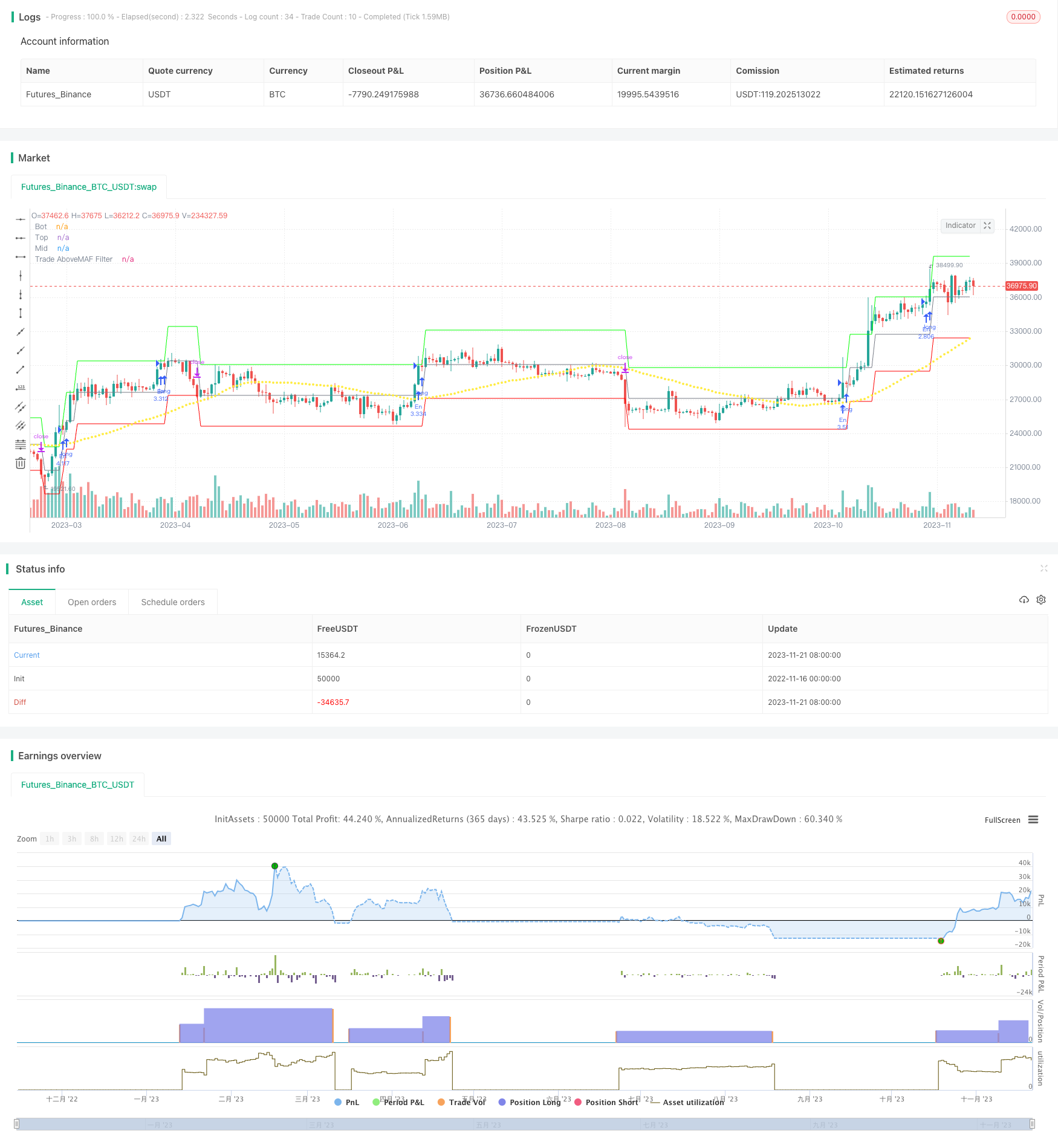
概述
这个策略利用价格的百分比变化来设定买入线和止损线,根据价格突破买入线来建仓,并在止损线下进行止损。它的主要特点是只承担一个单位的风险,即只有当上一个仓位达到预设的盈利目标后,才会加仓。
策略原理
该策略首先设置一个基准价格,以这个价格的10%为一个价格区间,上边缘为买入线,下边缘为止损线。当价格突破买入线时,以固定数量买入。当价格跌破止损线时,平仓止损。在获利后,买入线和止损线会按百分比调整,扩大盈利区间。这样可以追踪趋势运行。
该策略的另一个关键点是只承担一个单位的风险。也就是说,只有当前头寸已经达到盈利目标后,才会加仓新的头寸。新的头寸也会按新的买入线和止损线来设置。这样可以限制风险。
优势分析
这款策略结合了跟踪止损和加仓管理的优点,可以有效控制风险的同时盈利.
- 利用百分比区间设定买入线和止损线,可以自动跟踪趋势运行
- 风险控制到个位数,限制亏损
- 只在获利后加仓,避免追涨杀跌
- 获利后止损线上移,锁定利润
风险分析
该策略也存在一些风险:
- 百分比区间太大,买入线和止损线离得太远,风险放大
- 百分比区间太小,买入线和止损线离得太近,利润空间受限
- 停利点设置不当,可能会过早止损
- 加仓过于激进,可能亏损放大
这些风险都可以通过参数调整来规避,比如调整百分比区间大小,调整加仓条件等。
优化方向
这款策略还有进一步优化的空间:
- 可以结合趋势指标,确定趋势方向后才建仓
- 可以添加机器学习模型,让买入线和止损线更智能化
- 可以设置不同的加仓条件,使风险进一步降低
- 可以测试不同持仓时间,找到最佳持仓周期
总结
这是一款利用百分比区间进行交易的策略。它简单实用,有效控制了风险。通过参数调整和模型优化,这款策略可以成为一个可靠的趋势跟踪系统,为投资者创造稳定的超额收益。
策略源码
/*backtest
start: 2022-11-16 00:00:00
end: 2023-11-22 00:00:00
period: 1d
basePeriod: 1h
exchanges: [{"eid":"Futures_Binance","currency":"BTC_USDT"}]
*/
//@version=4
// This source code is subject to the terms of the Mozilla Public License 2.0 at https://mozilla.org/MPL/2.0/
// © HermanBrummer 4 April 2021
strategy ("The Box Percent Strat", shorttitle="The Box", overlay = true)
/// Designed for LONG only on Daily, 2D or 3D Charts
/// Uses fixed investment risk amount, meaning you're willing to lose that amount per trade
/// Limit buy to not overpay
RiskPerTrade = input(10000, "Risk losing this much per trade", tooltip="This calculates how much you will lose based on difference between the entry price and stop loss price")
TradeAboveMAFilterPer = input(50, "The System won't trade if price is below this MA")
UpBoxSize = (input(10, "Box size in %") * 0.01)+1 // 1.1 == 10% up
DnBoxSize = 1-(input(10, "Box size in %") * 0.01) // 0.9 == 10% dn
var FirstBar = close > 0 ? close : na
var FirstTop = FirstBar * UpBoxSize
var FirstBot = FirstBar * DnBoxSize
var top = sma(FirstTop, 1)
var bot = sma(FirstBot, 1)
/// The Box Calcs
if high[2] > top
top := top * UpBoxSize
bot := bot * UpBoxSize
if low[1] < bot
top := top * DnBoxSize
bot := bot * DnBoxSize
plot(bot, "Bot", #ff0000) // Green
plot(top, "Top", #00ff00) // Red
mid = ((top-bot)/2)+bot
plot(mid, "Mid", color.gray)
TradeAboveMAFilter = sma(close, TradeAboveMAFilterPer)
plot(TradeAboveMAFilter, "Trade AboveMAF Filter", color.yellow, 3, style=plot.style_circles)
// col = high[1] < top and high >= top ? color.white : na
// bgcolor(col)
/// Shares
RiskRange = close * abs(DnBoxSize - 1) // 0.9 - 1 == 1.10 // 10% abs so you don't get a neg number NB NB
Shares = RiskPerTrade / RiskRange
//plot(close-RiskRange, "RiskRange", color.fuchsia)
Enter = high >= top
and close[1] > TradeAboveMAFilter
and strategy.opentrades[0] == strategy.opentrades[1]
and strategy.opentrades[1] == strategy.opentrades[2]
and strategy.opentrades[2] == strategy.opentrades[3]
and strategy.opentrades[3] == strategy.opentrades[4]
and strategy.opentrades[4] == strategy.opentrades[5]
and strategy.opentrades[5] == strategy.opentrades[6]
// won't enter if new positon was taken in the last 6 bars
// need better code for this.
/// Buy & Sell
// (new highs) and (Close above moving average filter) and (No new trades were taken receently)
if Enter //(high >= top) and (close[1] > TradeAboveMAFilter) and strategy.opentrades[0] == strategy.opentrades[1]
strategy.order("En", strategy.long, qty=Shares, limit=top)//, stop=top)
//barcolor(strategy.position_size != 0 ? #00ff00 : color.gray)
// /// If ONE Position THEN this Stop Because:
// if strategy.position_size == 1
// strategy.exit("Ex", "En", stop=bot)
/// If it has more than one trad OPEN
if strategy.position_size > 0
strategy.exit("Ex", "En", stop=bot[2] ) // puts stop on old bot
//plot(strategy.position_avg_price, "Avg Price", color.yellow)